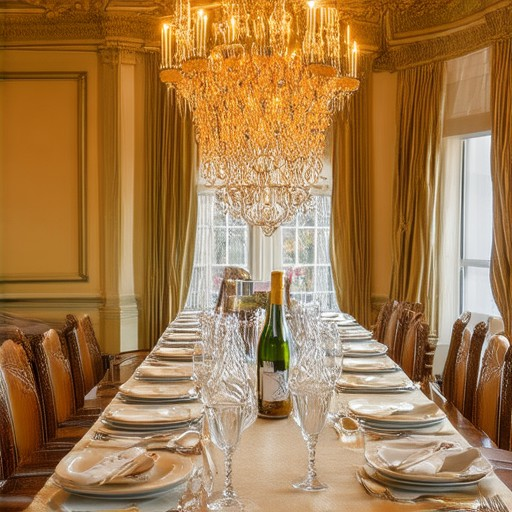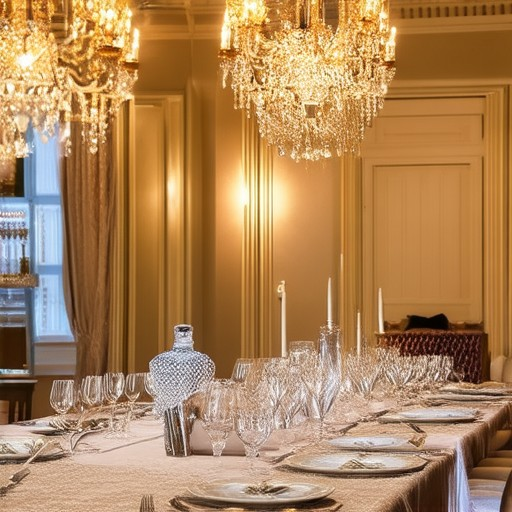Transforming your home into a restaurant-like environment might seem like a daunting task, but with the right creativity and planning, it’s entirely achievable. Whether you’re hosting a special occasion, entertaining guests, or simply enhancing your daily dining experience, creating a restaurant ambiance at home offers a unique way to elevate your space. By focusing on key elements like ambiance, cuisine, and overall guest experience, you can turn your humble abode into a memorable dining destination. In this article, we’ll explore how to make a home feel like a restaurant, the essential components that define a great dining experience, and how to do it all without breaking the bank. From setting the perfect scene to understanding the costs involved, we’ll guide you through the process of creating a restaurant-quality ambiance right where you are.

How to Make a Home Feel Like a Restaurant
To transform your home into a restaurant-worthy space, consider these tips:
- Dinnerware: Use your finest china, crystal glasses, and polished silverware to set the stage for an elegant meal. Enhance the experience with a variety of stemware for different beverages.
- Lighting: Create a warm and inviting atmosphere with soft LED candles, string lights, or low-level lighting. These elements mimic the cozy yet sophisticated ambiance of a restaurant.
- Music: Set the mood with a curated playlist featuring tracks from various genres that align with the restaurant’s theme. Consider using apps like Spotify or Apple Music for tailored playlists.
- Table Settings: Add place cards, menus, and monogrammed napkins for a touch of sophistication. Complete the look with a decorative centerpiece to tie the room together.
- Dishes and Drinks: Prepare restaurant-quality dishes using ingredients sourced from trusted suppliers. Explore recipes from reputable chefs and blogs like Memories Restaurant for inspiration.
- Service Style: Assign a dedicated host or hostess to welcome guests and assist with seating and needs throughout the evening, enhancing the dining experience.
- Decor and Arrangement: Use soft textures like throws and pillows to create a comfortable yet refined space. Arrange furniture to encourage social interaction and maximize the open feel of a restaurant.
- Personal Touches: Add personalized elements such as custom menus or handwritten notes to leave a lasting impression. Consider ending the meal with a dessert course inspired by renowned chefs.
By focusing on these details, you can create a memorable dining experience that rivals the finest restaurants, right at home.
The Three Cs of a Restaurant
In the realm of customer experience, restaurants often focus on three key principles to ensure satisfaction and loyalty among patrons. These principles are:
- Convenience : Providing an effortless dining experience. This includes easy access, clear signage, prompt service, and a simple ordering process.
- Consistency : Offering a reliable and high-quality experience every time. From the menu items to the ambiance, consistency builds trust and reliability.
- Connection : Creating meaningful interactions between the restaurant and its customers. This could be through personalized service, memorable moments, or fostering a sense of community.
By focusing on these three Cs, restaurants can create a seamless and rewarding experience for their guests, ultimately driving success and customer retention.

How to Create Ambiance in a Restaurant
To create an inviting and memorable dining experience, consider the following key elements:
- Lighting: Use dimmer switches to adjust the mood. Install ambient lighting to set the tone and incorporate task lighting for the kitchen area. Avoid harsh fluorescent lights.
- Sound: Play background music that aligns with your cuisine, such as jazz for Italian or classical for French. Soundproof walls and control noise levels to ensure a serene environment.
- Color Scheme: Opt for warm colors like deep reds or oranges to evoke warmth. Use lighter tones with accent colors to prevent a gloomy vibe.
- Furniture Placement: Arrange tables with adequate spacing to avoid cramped feelings. Invest in comfortable seating that complements your theme.
- Scent: Introduce subtle scents like scented candles or essential oil diffusions. Avoid overwhelming aromas that might distract diners.
- Personal Touches: Offer personalized menus or custom table settings to enhance guest experiences. Consider seasonal or event-themed decorations.
- Layout Design: Implement an open-concept design to foster socialization. Create separate sections for private events and ensure a smooth flow throughout the space.

Is 10,000 Enough to Open a Restaurant?
Starting a restaurant requires significant upfront investment, and $10,000 is often insufficient for most brick-and-mortar establishments. However, it can work for smaller-scale operations or food trucks.
Key Costs to Consider
- Location and Rent: Monthly rent varies widely by location, from $1,500 in smaller cities to $8,000 in major urban centers. Utilities (electricity, water, trash) typically cost $300-$600 monthly.
- Labor Costs: Hiring staff (management, chefs, waitstaff) can account for 30% of your budget. Expect to spend $3,000-$5,000 monthly on labor.
- Food Costs: Ingredients and supplies can range from $2,000-$5,000 monthly, with waste factored in due to spoilage.
- Equipment: A commercial kitchen requires ovens, refrigerators, and dishwashers. New equipment can cost $50,000-$200,000, while used equipment might still cost $20,000-$100,000.
- Furniture and Decor: Interior design and fixtures can total $15,000-$50,000, and signage and branding add another $5,000-$15,000.
- Licenses and Permits: Fees for health department approval, fire safety inspections, and liquor licenses can range from $500-$2,000 depending on your location.
- Marketing: Advertising, social media, and website development can cost $1,000-$5,000 monthly to attract customers.
Alternative Option: Food Trucks
If you’re considering a food truck, startup costs are lower, typically ranging from $10,000-$50,000. However, ongoing costs like propane and maintenance should also be factored in.
Total Estimated Investment
For a full-service restaurant, expect to invest between $250,000-$500,000. Food trucks may require half of that, though costs can vary significantly based on location and scale.
Remember, this is a general estimate. Factors like location, scale, and competition can greatly impact your actual expenses. For more details, visit our website or explore resources like Yelp and Michelin Guide for insights into running a successful culinary business.
Do Small Restaurants Make Money?
Small restaurants can indeed generate significant revenue, though profitability often depends on various factors such as location, concept, and operational efficiency.
Factors Influencing Profitability
- Location: Establishing a restaurant in a high-traffic area with demand for dining options can significantly boost revenue streams.
- Concept and Menu: A unique or niche menu that caters to specific tastes can attract dedicated customers, increasing profitability.
- Operational Efficiency: Streamlining kitchen operations, managing costs effectively, and optimizing staff scheduling can enhance profitability.
- Marketing Strategy: Effective marketing, including social media presence, local partnerships, and promotions, can drive foot traffic and sales.
Examples of Successful Small Restaurants
Many well-known restaurants started as small ventures that expanded due to their popularity. For instance, McDonald’s and Starbucks began as modest locations that grew into global franchises.
Challenges Faced by Small Restaurants
Despite potential profitability, small restaurants face challenges such as limited funding, competition from larger chains, and higher overhead costs compared to their size.
Strategies for Success
- Focusing on quality ingredients and exceptional customer service to differentiate from competitors.
- Utilizing digital tools for ordering and payment to streamline operations and enhance customer experience.
- Leveraging social media platforms to connect with local communities and promote special offerings.
Memories Restaurant understands the importance of balancing these factors to create a profitable and enjoyable dining experience. By focusing on a strong concept, efficient operations, and meaningful connections with customers, small restaurants can thrive in competitive markets.

Is it true that it cost 10k to open Chick Fil A?
Yes, the initial financial commitment to open a Chick-fil-A franchise typically ranges between $10,000 to $15,000. This cost covers various expenses including equipment, inventory, and training. However, this figure may vary depending on factors such as location, size of the restaurant, and other variables.
Chick-fil-A franchisees often require a significant investment beyond the initial fee due to ongoing operational costs, lease agreements, and marketing efforts. It’s important to consult with the company directly for the most accurate and up-to-date information regarding franchise opportunities and requirements.
Competitors in the fast-food industry may have similar financial requirements, though each brand has its own unique setup. It’s advisable to research thoroughly before pursuing any franchise opportunity to ensure alignment with personal financial capabilities and business goals.
The decision to invest in a Chick-fil-A franchise is a serious one, reflecting a commitment to quality, customer service, and operational excellence. Remember, this investment is about building a lasting business that can thrive in the competitive landscape of quick-service restaurants.




0 Comments